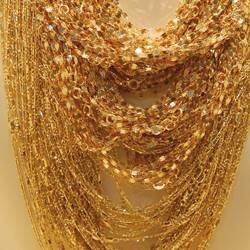|
News
Articles from GOLD JEWELLERY (768 Articles)

Despite Australia's gold production soaring, the domestic jewellery industry's use of that gold has decreased
Australia’s gold jewellery production on way down
Posted April 19, 2011 | By Sonia Nair
The 2011 World Gold Survey has found that although Australia’s gold mine production soared last year, the domestic jewellery industry's gold production has decreased.
For the second year running, Australia was the second highest gold-producing country in the world after China. 2010 was a monumental year of growth for Australia, with gold mine production soaring 16 per cent from 2009 to 261 tonnes.
The upsurge was attributed to a number of operations that commenced in 2009 and several mothballed mines that had also re-started production since June 2009.
Australia’s growth helped boost the overall mine production of the Oceania region, which reported the largest increase of any region, according to the survey.
Yet despite its high gold production figures, Australia’s gold jewellery production was 3.2 tonnes in 2010 - the same as 2009 and a minute proportion of the 261 tonnes of gold it produces.
While Australia’s gold jewellery production was at a low level, a surge in Indian demand for gold was the primary factor behind a leap in global gold jewellery production, as it rose by 15.6 per cent in 2010, according to the survey.
Positive sentiment towards gold in India outweighed the impact of a 20 per cent increase in the rupee price. Similarly, jewellery production in China jumped almost 20 per cent to exceed the 400 tonne mark for the first time.
India recorded the highest gold jewellery consumption figures at 657.2 tonnes, followed by China at 451.8 tonnes and then United States at 128.6 tonnes.
Industrialised nations lagged behind their developing counterparts when it came to gold jewellery consumption. The survey attributed this disparity to “gold’s elevated prices [which] pushed retail price points above key levels and made the financing of trade stocks yet more burdensome.”
While South and East Asia boosted global gold production levels, the largest decline in gold jewellery production was seen in the Middle East, with Turkey and Saudi Arabia the biggest contributors behind this drop.
Gold jewellery trends
A growing affinity for vintage styles and naturalistic pieces sparked a rise in demand for rose gold jewellery in 2010, according to the survey.
In the face of austere economic times, the survey observed consumers moving increasingly towards discrete designs and away from artificial styles.
In many markets, retailers reported a rising trend of younger consumers turning to silver due to its “youthful image”, according to the report.
Consumers were not the only ones to change their spending patterns. Retailers dealing with the escalating gold prices either switched to lower carat products or moved towards delicate open-work styles that used less gold and exposed more skin.
For a more in-depth analysis of the local manufacturing scene, read the digital edition of our Australian brands special report that was published in April Jeweller.
More reading:
India and China continue to power gold jewellery demand
WGC forecasts 2011 gold jewellery trends
Global silver jewellery production hits five-year high
|
|
|
|